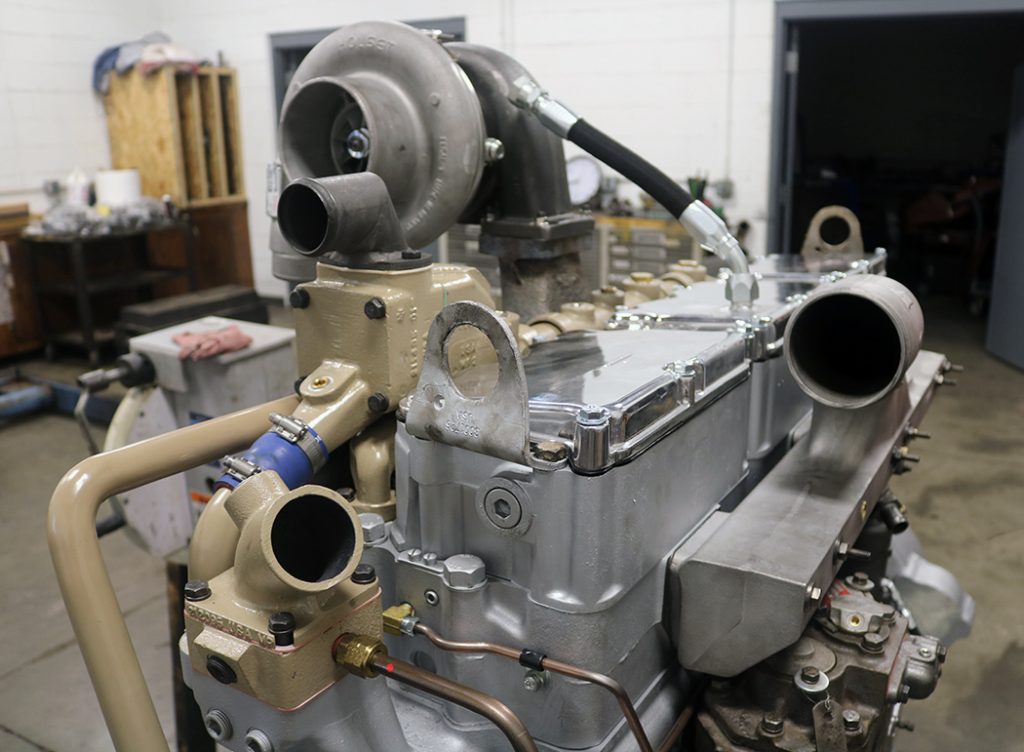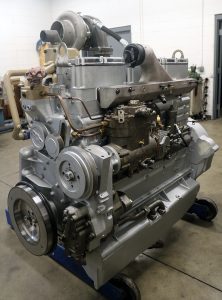
Years ago, when the Big Cam Cummins engine was in 74% of all trucks sold in North America, we at Pittsburgh Power developed 42 items to improve the power, longevity, and fuel mileage of this wonderful engine. Back then, we really knew this engine well – and we still do. Then, one morning a well-dressed man named Al Puhlman walked into my office with one of my magazine articles and asked me if I was the writer. My answer was yes. He proceeded to tell me he had a Big Cam 3 in a Crown bus that he converted into a motorhome, and the engine laid on its side halfway back in the bus under the floor. I leaned back in my chair, looked at him, and thought to myself, I have heard a lot of stories, but this one takes the cake!
Like I said, he was a good-looking, well-dressed, and well-spoken man, so I said, “When can I see this motorhome?” He said, “Tomorrow. It’s parked at a campsite in Washington, PA right now.” Now this was back around 1996. The next morning, it was in my parking lot, and it was an absolutely gorgeous motorhome. The side compartment was open, and there was the Big Cam Cummins engine with chrome valve covers lying on its side. I just stared at it, wondering how the oil pan and oil pump supplied oil to the engine. I thought this was impossible, so I got a creeper out, slid under the motorhome, and saw the strangest looking oil pan I have ever seen.
The engine was actually on a 3-degree rise from being completely horizontal, enough to allow the oil to return back to the pan. That day, a wonderful friendship began. He wanted a lot of horsepower, and I was the one that made his dream come true. This Crown motorhome started life as a Crown mobile post office powered with an NH 220 Cummins engine. Al and his son converted this traveling post office into a stunning motorhome and installed the Big Cam Cummins engine under the floor. This motorhome has 34 gauges, 17 hides of leather, a 36” television that comes up out of an end table, and the list goes on. The horsepower is around 700, but we did not have a dyno at the time to verify the power. Al Puhlman was raised in Western Pennsylvania, and in 1962 his family moved to Southern California. Today, this cool and unique motorhome is in Round Mountain, California, near Redding.
In 2023, a customer brought us another Big Cam Cummins engine to go into a 1938 Harlan bus to set the land speed record at Bonneville Salt Flats. We are currently building this engine, which is around 750 to 800 horsepower, and it will be situated in the bus with the intake manifold facing the ground. Stay tuned for more about this fun project!
Let’s move on to another subject: the pitfalls of EGR systems. EGR (Exhaust Gas Recirculation) was introduced to the trucking world and has been with us for over 20 years. The introduction of hardware that lowered emissions reshaped the industry, and emissions regulations continue to shape our world. From a repair shop perspective, our world went from rebuilds, injectors, and pumps to EGR coolers, DPF cleaning, and DEF diagnostics. The technicians of today live in a different reality than years ago. Hearing an engine roar to life after a new pump and injectors was satisfying. A technician’s job now is borderline “nerdy” with all the computers and wiring involved. So, back to EGR, why did the OEMs use that technology, and how does EGR reduce NOx?
For starters, DEF and SCR (Selective Catalytic Reduction) are the superior technologies, but they weren’t ready for mass production in 2003 when EGR came out. EGR is one of the simple and effective ways to reduce the NOx coming out of the engine. The biggest reason EGR is so effective is that it decreases the peak temperature of the combustion flame. It does this through the dilution effect, a thermal effect, and an added mass effect. The dilution effect is a fancy term, which is what it sounds like. The gulp of air that the cylinder takes in is diluted with EGR. The combustion flame has to try harder to find oxygen in the cylinder to burn with. The less oxygen there is, the more “leftover” fuel molecules there are, and soot forms more easily.
The “added mass effect” and “thermal effect” work with the dilution effect. When you dilute the intake with something other than burnable oxygen, that something takes heat away from the combustion. When combustion happens, there is a large release of heat. That heat and pressure is what pushes the piston down, but not all that heat goes into pushing the piston. Some of it is distributed to the block, pistons, and exhaust, to name a few, which all absorb the heat. Hence, engines get hot. EGR in the cylinder takes heat away and reduces the amount of push on the piston. This is one of the reasons why EGR hurts power and fuel mileage. These three effects reduce cylinder temperature, which reduces NOx formation. Since NOx needs heat and pressure, reducing those components makes it harder to form.
There are many downsides to utilizing EGR, and the ECM tries its best to manage how much it puts in. OEMs know the downside and only put in what they have to. That is why, in some ways, the introduction of DEF and SCR has been a blessing. Using those technologies means the engine has to eat less of its own waste. One major issue with using EGR is in the design itself. Most OEMs use a high-pressure EGR system. This system works off the fundamental physics property that pressure will always try to equalize itself. So, areas of high pressure will flow to areas of low pressure. In the case of an EGR system, the turbocharger generates high pressure in the exhaust manifold, so it will flow into the intake manifold. The more boost your engine makes, the higher the exhaust back pressure to drive EGR into the intake. High exhaust back pressure leads to less performance and reduced fuel mileage – this is a known fact.
The other downside we mentioned earlier is the decrease in the combustion performance. This decrease in combustion performance also comes with higher particulate matter emissions (soot). Displacing oxygen in the cylinder for exhaust gas, which doesn’t burn with diesel, leads to rich pockets in the cylinder. These pockets contain unburned fuel and, if not dealt with, will accumulate, and grow into soot particles. The larger particles get trapped in sensors and your DPF. This is why whenever you have an EGR sensor acting up, it will lead to even more issues with soot buildup. Soot oxidation rate, the rate at which soot burns, is affected by EGR, especially in the later stages of combustion. This is where Max Mileage can help. By lowering the temperature at which the soot breaks down, Max Mileage will make soot easier to burn in those later stages, undoing some of the harm that EGR causes.
This month’s article was written by me, Bruce Mallinson, and Leroy Pershing. If you have any comments or questions, stop by our shop in Saxonburg, PA, call us at (724) 360-4080, or visit our website 24/7 at www.pittsburghpower.com. We are here to help you!


